- Home
- Digital Marketing
- Glossary What Is Inbound Marketing?
What Is Inbound Marketing? Your Guide to Attract and Convert Customers
Cold outreach and chasing customers aren’t the only ways to get your audience’s attention. Inbound marketing is a strategy that acts like magnet, attracting people to your business and offerings.
Discover how you can effectively employ inbound marketing strategies to improve your brand awareness and grow your bottom line through these topics:
- What is inbound marketing?
- Why is inbound marketing important?
- Inbound vs. outbound marketing
- How does inbound marketing work?
- 3 stages of inbound marketing
- 5 inbound marketing strategies (plus examples)
- Limitations of inbound marketing
Let Prospective Clients Come to You
Download our guide to see how you can use inbound marketing tactics to get in front of qualified business looking for your products or services.
Get My Free Guide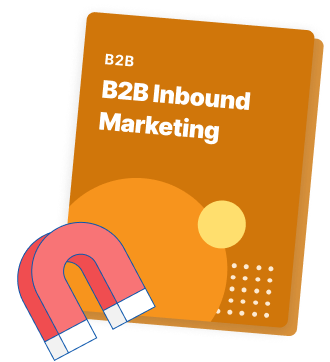
Understanding inbound marketing
What is inbound marketing?
Inbound marketing is a digital marketing strategy that attracts your target audience to your brand, as opposed to your team reaching out to them.
It can refer to any kind of activity that earns attention, as opposed to an activity that pays for it.
Inbound marketing draws your customers to your business through experiences and content tailored to their interests and pain points. Businesses can customize their inbound marketing strategies and use tactics like the following:
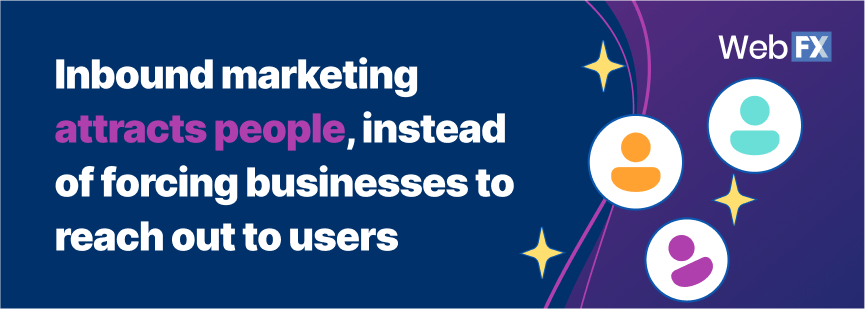
Why is inbound marketing important?
Implementing inbound marketing strategies provides various benefits, including boosting your site traffic and establishing your credibility. It can drive your target audience to your site, where you can provide them with helpful information and nurture your relationships with them.
Here are the benefits of inbound marketing:
- It drives traffic to your website
- It establishes your company’s credibility and trustworthiness
- It’s a cost-effective way to build relationships with your audience
- It generates qualified leads
Let’s go through each one:
1. It drives traffic to your website
An effective inbound marketing strategy typically involves content marketing and SEO.
Content marketing focuses on creating resources that help your prospects learn about a topic, product, or business. Meanwhile, SEO is a strategy focused on improving your website’s presence in search engine results pages (SERPs).
Together, content marketing and SEO can drive qualified traffic and leads to your website. In fact, content marketing is three times more efficient at generating leads than outbound marketing.
2. It establishes your company’s credibility and trustworthiness
Creating useful content that your prospects search for is an important aspect of inbound marketing. By creating content that helps your prospects address their pain points, you establish yourself as:
- A trustworthy resource
- An authority in the industry
- A helpful brand
For example, let’s say you’re marketing a forklift dealer business. By publishing a blog post about how to choose the right forklift, you enable your target audience to find your brand when they’re in the early stages of their research.
They’ll perceive your brand as a helpful and credible one, because you’ve provided them with valuable intel on picking the best forklift for their needs.
3. It’s a cost-effective way to build relationships with your audience
Inbound marketing is an economical way to nurture your relationships with your customers. By showing them you understand their needs and are willing to help them with their pain points before, during, and even after their purchase, you’re improving how they view you as a business.
For example, let’s say you own a pest control business. You can nurture your relationships with your existing customers by emailing them useful information about seasonal pests and what they can do to avoid them.
Such an effort shows your customers that you are an expert that provides free, helpful tips for them.
4. It generates qualified leads
Fun fact: Inbound marketing is 54% more effective than traditional marketing at lead generation. By creating content that’s targeted at consumers who are looking for your services or relevant information, you’re driving qualified traffic and leads to your website.
If you own a jewelry store business, inbound marketing strategies attract consumers looking for your products or information about the jewelry pieces you offer. On the other hand, traditional marketing strategies may target people who aren’t interested in jewelry at all.
Inbound vs. outbound marketing: What are their differences?
Inbound marketing focuses on creating and sharing content that draws people to your brand. Meanwhile, outbound marketing focuses on reaching out to prospects to generate interest in your brand.
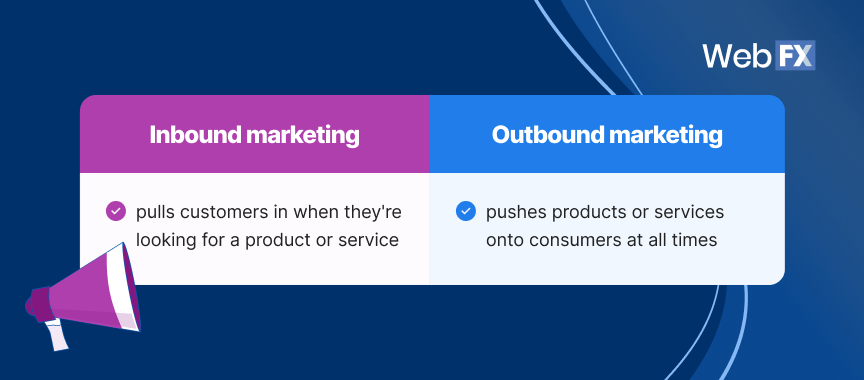
Consumers are learning to tune out outbound marketing methods or are finding ways to avoid them.
For example, when a TV commercial comes on, a consumer may simply change the channel. A spam email may automatically be filtered to the “spam” folder, or deleted without being read.
Those who rely solely on outbound marketing methods are finding that they are not as effective as they once were nor do they provide the desired return on investment (ROI). Inbound marketing, on the other hand, gives marketers a chance to “earn their way in.”
For example, instead of a TV commercial, a jewelry company may produce a detailed guide on caring for jewelry pieces or publishing a blog post. When the consumer needs it, they will find it in a search and become aware of that company. This earns more trust than an intrusive commercial and may also have a higher ROI.
As mentioned, inbound marketing brings people in, as opposed to requiring marketers to reach out. This is the crucial difference between the two.
How does inbound marketing work?
Inbound marketing works like a finely tuned orchestra. Like the musical ensemble that comprises several instruments, inbound marketing has several “instruments” or digital marketing strategies, such as SEO, content marketing, or social media marketing.
These strategies play unique roles, depending on how your business uses them in your campaigns. Despite playing their own tunes, they all work in harmony to attract, engage, and retain your ideal customers, ultimately boosting your bottom-line growth.
What are the stages of inbound marketing?
Inbound marketing has three stages to effectively draw your target audience to your business and retain them as customers:
3 stages of inbound marketing
Let’s dive into each stage:
1. Attract
The first stage of inbound marketing is the attract stage. At this stage, your prospects are researching possible solutions for their pain points.
You can draw your audience to your business by publishing helpful content and optimizing your webpages to rank in SERPs.
In the attract phase, your goal is to let your audience know that you understand their needs and you can help them.
2. Engage
The second stage is engage. Once you’ve piqued their interest, your prospect will interact with you.
They might fill out a form to send an inquiry, sign up for a free trial, or purchase your product. At this stage, it’s important to provide value to your prospects and customers so they’ll consider repurchasing from you or building a long-term relationship with your business.
3. Delight
The final stage in inbound marketing is delight, which ensures your customers are satisfied with their purchase. They must also be happy with the after-sales support you give them.
At this stage, focus on keeping your customers satisfied and supported to foster loyalty. You can send out surveys to gather feedback on how you can improve your product or after-sales service to better suit their needs.
5 inbound marketing strategies to grow your business
You can employ multiple inbound strategies according to your business, audience, and sales cycle. Understanding how each strategy attracts, engages, and delights customers is key, so you can prioritize your campaigns.
Here are common inbound marketing strategies you can employ:
Let’s go through each one!
1. Content marketing
Content marketing is an excellent way to attract and delight your ideal customers. In fact, 32% of businesses cite it as an effective digital marketing technique to retain their customers.
With this strategy, you create helpful content that provides answers to your customers’ pain points. These content pieces make it more likely for your audience to find your website when they search online. In addition, it also helps those who know your brand feel an affinity toward you.
Content tips for inbound marketing
- Experiment with different content offerings and content types: Discover what works best for your business and what resonates with your audience by publishing content in various formats. Try interactive content (like quizzes and calculators), webinars, case studies, and video series.
- Promote your content across multiple channels: Make it easy for your customers to discover your content by promoting it on social media or through email newsletters.
- Use AI for topic research and content gap analysis: While we don’t recommend publishing AI-generated content, we do recommend using AI tools to help you with your content marketing efforts. AI content optimization involves auditing your existing content to identify gaps and opportunities, while AI content personalization provides a customized experience for your users.
2. Social media marketing
Social media marketing is also another component of inbound marketing. With people spending an average of 151 minutes a day on social media, it makes sense to be present where your customers are.
While it can be used to reach new customers or potential leads, it can also grow relationships with existing ones by offering helpful content or great service at the right times.
For example, let’s say you own a car dealership. You can create a short-form video about a vehicle you’re promoting and provide a link to your website so that they can visit it when they want to learn more.
Social media tips for inbound marketing
- Choose the right social media platforms: Establish your presence in the social media platforms where your target audience is.
- Repurpose your blog posts or website content: Turn your existing content into bite-sized social media posts or short videos.
- Employ AI-powered social listening: Monitor brand mentions using AI-powered social media listening tools to better understand your customers’ sentiments.
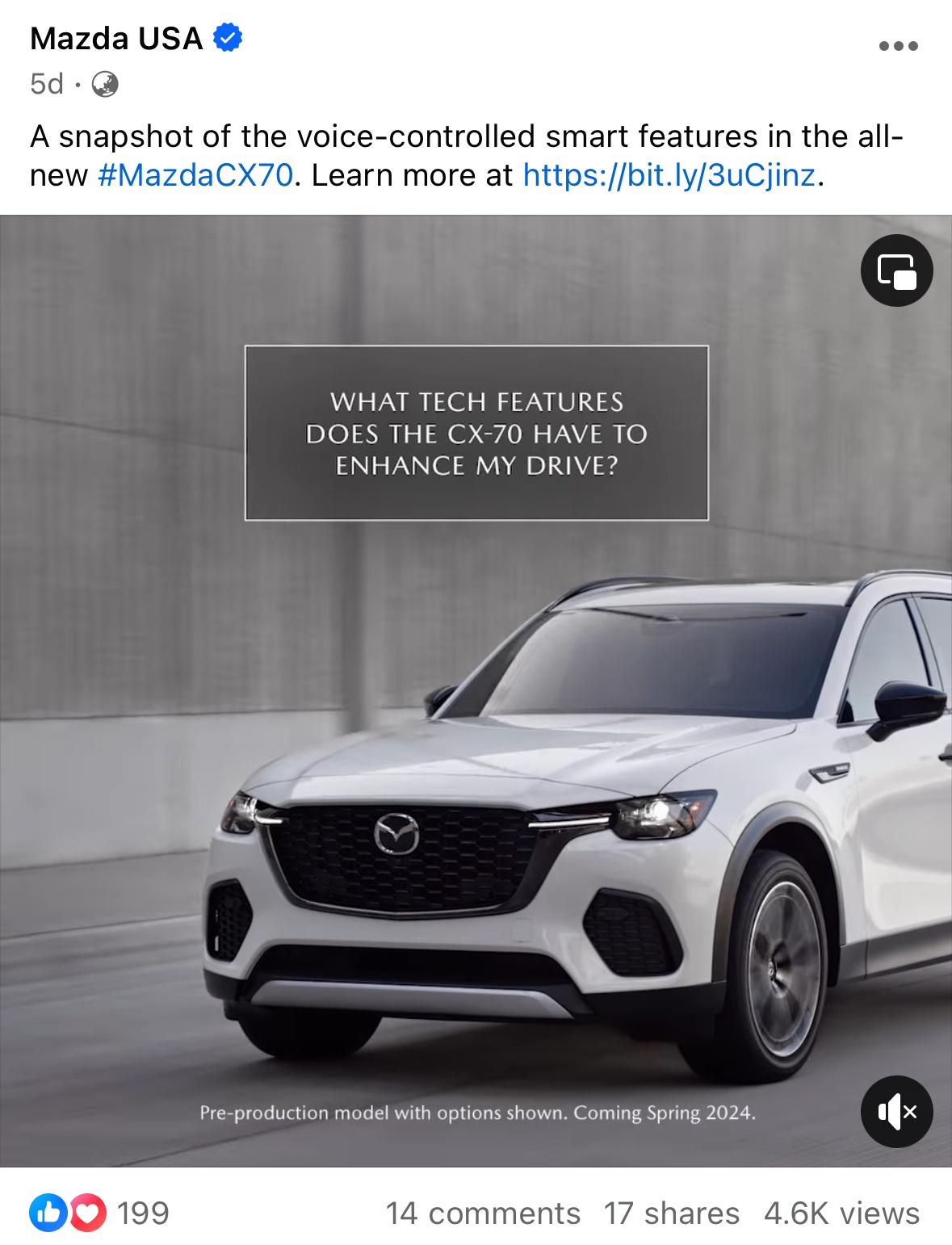
Creating groups on platforms like Facebook and LinkedIn enables you to interact with your audience and foster an online community. Your group members can ask questions and respond to questions from fellow members.
You can also post announcements and provide support through your groups, which are an excellent avenue to cultivate customer loyalty.
3. Email marketing
Email marketing may not seem like a form of inbound marketing, but because you must get permission before emailing anyone (you do ask for permission, right?) it appears solidly on the inbound list.
Like social media, email is typically used to grow existing relationships by offering something desirable at the right time. Use email marketing as part of your inbound marketing strategies by offering more than just sales or deals in your emails.
Email tips for inbound marketing
- Segment your email list and send personalized emails: Ensure you’re sending relevant messages to your audience by segmenting them accordingly. Then, personalize your emails and messages, sending only relevant and helpful content for each group.
- Use automation: Automate your email drip campaigns to nurture leads and guide prospects through your funnel.
- Optimize your emails with AI tools: Use AI-powered tools to test your subject lines and improve open rates. Some tools can also determine the best times to send your emails.
4. Personalization
Every day, your prospect receives a lot of marketing messages. To stand out among your competitors, you must provide them with personalized, relevant information.
Fun fact: 72% of customers say they only engage with personalized marketing. That said, it’s more important than ever to implement personalization strategies to get noticed by your prospects and stand out among your competitors.
To effectively personalize your audience’s experience, make sure you know your audience well, including their interests or needs.
For example, let’s say you’re a pet store owner with multiple brick-and-mortar locations in different cities. People who visit your site from a particular city will see a website that’s tailored to their location. They can view the products and services that are available at your nearby store.
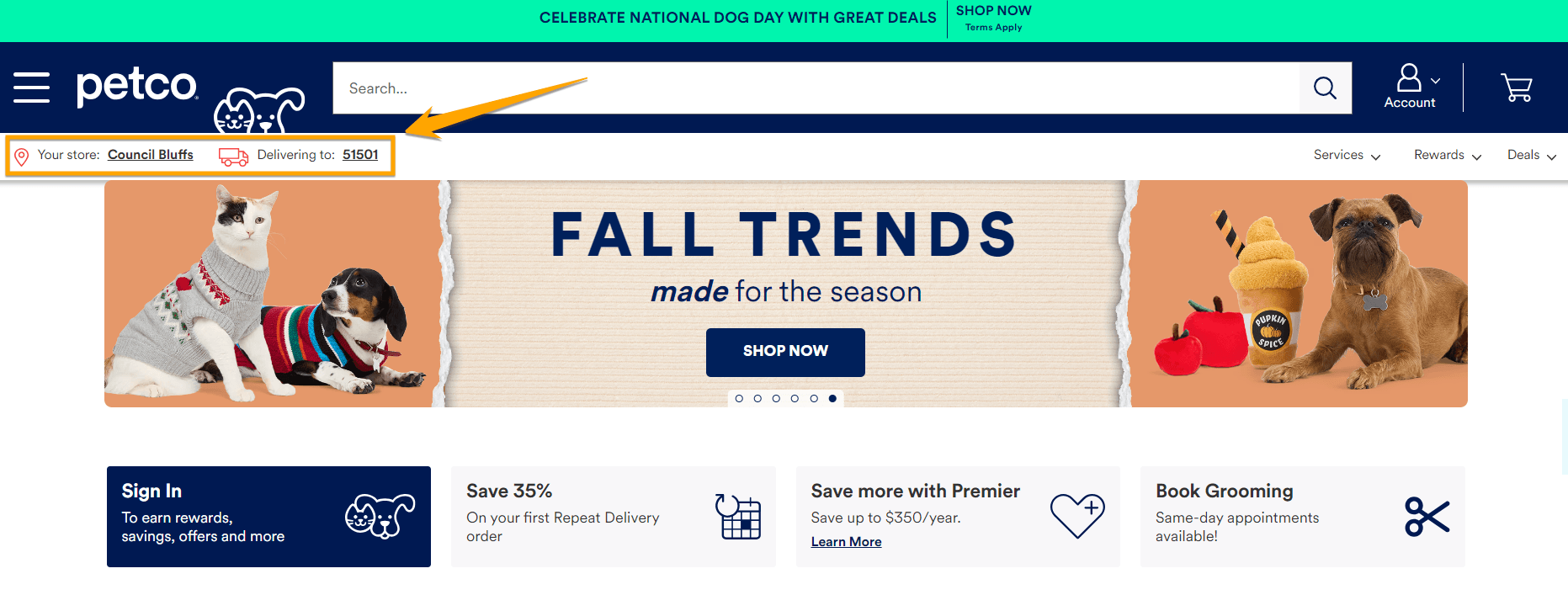
In our pet store owner example earlier, you can implement a personalized email marketing campaign by sending only the relevant products and information to each customer segment.
For example, you can segregate your customers according to their pets, their pets’ age, and needs. A newsletter campaign for senior dog owners can share tips on senior dog nutrition and provide special offers on related products.
Meanwhile, pet guardians who own kittens don’t get the same newsletters. Instead, they receive information on products for kittens and kitten-proofing their homes.
5. SEO
Yes, SEO is a crucial part of inbound marketing. After all, where would your other inbound marketing strategies get you if they weren’t properly optimized or your audience can’t find you online?
If you’re not already familiar with SEO, it’s an important part of online marketing in which your website is optimized to rank in search results for relevant searches. SEO is the difference between ranking #1 and ranking #10, and determines which websites take the top spots for any specific search query.
Without SEO, which ensures your content is as search engine-friendly as possible, even your best content would have no chance of reaching your target audience.
For example, let’s say you’re in the business of heavy equipment rental. You can perform an SEO audit of your website using our SEO Checker to identify optimization opportunities.
Then, you can start with keyword research to unearth search terms that your audience uses when searching for your offerings or competitors.
Pro tip: Implement white-hat SEO strategies to outrank your competitors and provide value to your audience. These tactics also increase your visibility in AI searches.
🎥 How SEO Increases Market Share for Your Business
Limitations of inbound marketing
While inbound marketing offers many benefits, it has limitations, too:
- It takes time: You won’t get instant results like increased sales with inbound marketing. This strategy typically takes time to show results because it involves creating content, fostering trust, and engaging with your prospects.
- It requires effort: Inbound marketing is an ongoing strategy. It involves creating new helpful content for your prospects and repurposing content to reach new audiences. Then, you need to analyze your content marketing efforts’ performance to identify new opportunities.
- It needs advanced analytics to measure its ROI: Attributing new leads and sales to your inbound marketing efforts requires advanced analytics platforms. Thankfully, tools like RevenueCloudFX enable you to measure your inbound marketing efforts, attribute leads, and inform your strategy with data and insights!
Our digital marketing campaigns impact the metrics that improve your bottom line.
See Our Approach
$10 billion

24 million

7.14 million
Employ inbound marketing strategies to drive business growth
Inbound marketing is a cost-effective way to sustainably drive business growth. If you need help with implementing various inbound marketing strategies, consider partnering with WebFX.
We’re pumped to get to know your business, goals, and customers, to craft a personalized inbound strategy that will grow our bottom line.
Our team of 500+ marketing experts is excited to learn more about your business and goals, and craft an inbound marketing strategy that will drive revenue for your business.
When you’re ready to experience award-winning web design, SEO, and inbound marketing from one of the nation’s best marketing teams, we’d love to hear from you.
Contact us online or call us at 888-601-5359 to speak with a strategist about our inbound marketing services!
Table of Contents
- Understanding Inbound Marketing
- Why is Inbound Marketing Important?
- 1. It Drives Traffic to Your Website
- 2. It Establishes Your Company’s Credibility and Trustworthiness
- 3. It’s a Cost-effective Way to Build Relationships with Your Audience
- 4. It Generates Qualified Leads
- Inbound vs. Outbound Marketing: What Are Their Differences?
- How Does Inbound Marketing Work?
- What Are the Stages of Inbound Marketing?
- 1. Attract
- 2. Engage
- 3. Delight
- 5 Inbound Marketing Strategies to Grow Your Business
- 1. Content Marketing
- 2. Social Media Marketing
- 3. Email Marketing
- 4. Personalization
- 5. SEO
- Limitations of Inbound Marketing
- Employ Inbound Marketing Strategies to Drive Business Growth
Related Resources
- What is Ecommerce Digital Marketing?
- What is Full-Service Internet Marketing?
- What is Growth Marketing?
- What is Inbound Lead Generation?
- What is Internet Marketing?
- What is Marketing?
- What is Search Marketing?
- What is Web Marketing?
- 2025 Inbound Marketing Strategies [3+ Strategies for Success]
- 10 Reasons Why Inbound Marketing Works
Marketing Tips for Niche Industries
- Travel and Tourism Marketing Budget
- Urgent Care Marketing Ideas: 5 High-ROI Tactics
- Vision Care Industry Statistics
- WebFX: Your Education Digital Marketing Agency
- Why Auto Part Retailers Need Digital Marketing
- Why Digital Marketing is Essential for Auctioneers
- Your Guide to Digital Marketing for Exercise Equipment Companies
- Your Guide to Digital Marketing for Industrial Repair Companies
- 2025 Professional Services Trends: Embracing the Future
- 6 Best Heavy Equipment Marketing Agencies
